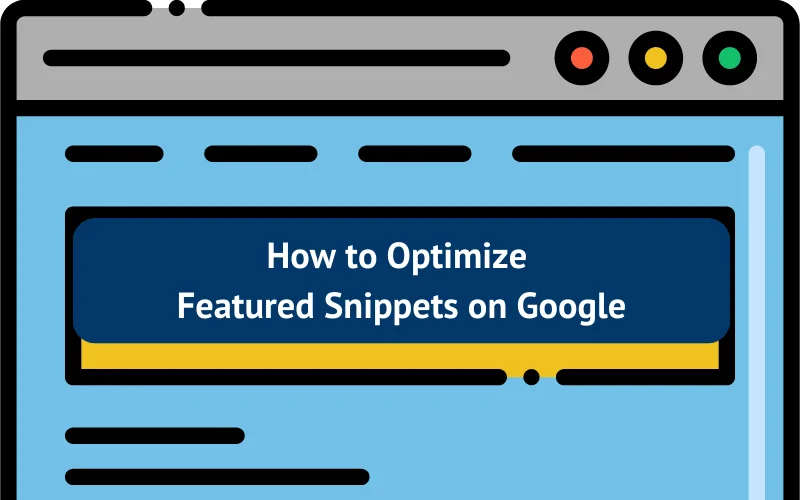Are you struggling to increase your website’s visibility and organic traffic?
Optimizing for featured snippets on Google can be a game-changer.
In this blog post, we’ll dive deep into the world of featured snippets and uncover strategies to make your content stand out.
Get ready to boost your search rankings and give your competitors a run for their money.
TL:DR
- Understanding featured snippets is essential for effective SEO and can improve website visibility, credibility, and organic traffic.
- Optimizing content for different types of featured snippets involves keyword research tools, analyzing competitors’ strategies, crafting concise fact-based content with structured data markup & engaging headings/subheadings.
- Engaging an SEO agency to optimize for featured snippets offers technical proficiency & increased clickthrough rates to focus on core business.
What are Featured Snippets
Featured snippets are short, concise answers to user queries that appear at the top of Google search results, also known as Google’s featured snippets.
These snippets offer additional visibility for the linked site, aligning with the search intent of users and providing quick answers to their questions.
By winning featured snippets, your website can secure a prime position in search results, attracting more visitors and broadening your reach.
The importance of featured snippets in your SEO strategy cannot be overstated.
Not only do they increase your website’s visibility, but they also bolster your credibility and help you compete with other websites for the coveted “position 0” in organic search results.
By creating content that triggers featured snippets, you can tap into a wealth of search volume and drive more traffic to your site.
The Purpose of Featured Snippets
The primary intent of featured snippets is to enhance user experience and search efficiency.
By providing users with immediate answers to their queries, Google displays the featured snippet box at the top of search results.
This gives your website the opportunity to be the first source of information for users, increasing the chances of them clicking through and exploring your content.
Featured snippets offer a range of benefits, including increased visibility, higher organic traffic, and a competitive advantage over other results.
By developing a “how-to” section or a Q&A/frequently asked question section on your website, you can address related search queries and increase your chances of being featured in snippets.
Impact on SEO and Organic Traffic
Featured snippets can significantly boost organic click-through rates, enhance brand visibility, and bolster credibility, making them an integral part of SEO strategy.
By securing a featured snippet, you directly contribute to contextualized search visibility for your brand or business, increased and better-qualified website traffic, demonstrated website authority, and ultimately, more customer conversions.
To make the most of featured snippets, it’s essential to optimize your content for search queries that are likely to trigger them.
By focusing on informational search queries and crafting concise, fact-based content, you can increase your chances of appearing in a featured snippet and reaping the benefits of improved SEO performance.
Types of Featured Snippets and How to Optimize for Them
There are four main types of featured snippets: paragraph, list, table, and video.
Each type requires specific optimization techniques to increase the chances of being featured.
In the following sections, we’ll explore each type of featured snippet and provide actionable tips to help you optimize your content accordingly.
Paragraph Snippets
Paragraph snippets are concise answers to user queries that appear at the top of search results.
To optimize for paragraph snippets, it’s essential to craft clear and concise content that directly responds to user queries in the 40-50 word range.
By providing a succinct answer within this word count, you increase the likelihood of being featured in a paragraph snippet.
One way to ensure your content is suitable for paragraph snippets is to focus on answering specific user queries.
This can be achieved by conducting keyword research and identifying long-tail keywords that are closely related to the topic at hand.
By providing concise, fact-based answers to these queries, you can improve your chances of securing a paragraph snippet and boosting your website’s visibility.
List Snippets
List snippets are another type of featured snippet that can help improve your website’s visibility.
These snippets present information in an ordered or ordered list format, making it easy for users to digest the content.
Bulleted lists may be used for both ranked and unranked items, features, and “best of” types of lists.
To optimize for list snippets, it’s crucial to structure your content in a way that is easily understandable for both users and search engines.
By formatting your content as an ordered or ordered list, you can help users quickly comprehend the information and increase your chances of being featured in a list snippet.
Table Snippets
Table snippets are an excellent way to present data in a tabular format for convenient analysis and comprehension, particularly when displaying numerical information.
A table featured snippet facilitates users to visualize data for diverse types of comparisons.
To optimize for table snippets, it’s essential to display data in a tabular format, making it easy for users to compare and understand the information presented.
By organizing your content in this manner, you can increase the likelihood of being featured in a table snippet and improve your website’s search visibility.
Video Snippets
Video snippets are brief segments of video content that are featured in search results due to structured markup.
These snippets enable videos to show up in organic search results, making them a unique type of snippet to optimize for.
High-quality videos with transcripts that address user inquiries, particularly those related to “how-to” content, are suitable for video snippets.
To optimize for video snippets, focus on creating engaging, informative, and high-quality video content that answers user queries.
By providing transcripts and optimizing your video content for search engines, you can increase your chances of being featured in a video snippet and drive more traffic to your website.
Keyword Research and Identifying Featured Snippet Opportunities
Conducting thorough keyword research is essential for finding search queries that trigger featured snippets and uncovering potential opportunities.
By analyzing competitors’ snippets and using keyword research tools, you can identify areas for improvement in your own content and increase your chances of being featured in snippets.
Optimizing your content for featured snippets can help you stand out from the competition and drive traffic.
Using Keyword Research Tools
Keyword research tools like Ahrefs and SEMRush can help you pinpoint keywords that trigger featured snippets and analyze competitors.
These tools provide valuable insights into search volume, competition, and relevance, allowing you to identify the best target keywords for your content.
By leveraging these tools, you can develop a comprehensive understanding of the search landscape and uncover potential opportunities for featured snippets.
This information can be invaluable in guiding your content creation efforts and ensuring that your content is optimized for the search queries that are most likely to trigger featured snippets.
Analyzing Competitors’ Featured Snippets
Examining competitors’ snippets can provide valuable insights into their optimization strategies and help you identify potential areas of improvement in your own content.
By analyzing the content and format of their snippets, you can gain a better understanding of what Google is looking for in a featured snippet and tailor your content accordingly.
Tools such as SEMrush, Ahrefs, and Google Search Console can be employed to facilitate this analysis.
By regularly monitoring and analyzing competitors’ featured snippets, you can stay ahead of the curve and ensure that your content remains optimized for the ever-changing search landscape.
On-Page SEO and Content Optimization for Featured Snippets
In addition to keyword research and competitor analysis, optimizing on-page SEO and content is crucial for increasing your chances of being featured in snippets.
In this section, we’ll explore the key aspects of on-page SEO and content optimization, focusing on headings, concise content, and structured data.
Creating Engaging Headings and Subheadings
Headings and subheadings play a vital role in organizing and formatting your content, making it more accessible and providing concise answers to user queries.
By employing H2 and H3 tags to organize content into logical sections, you make it easier for both users and search engines to understand your content and increase your chances of being featured in snippets.
When crafting headings and subheadings, make sure to include relevant keywords, maintain descriptiveness and conciseness, adhere to a consecutive hierarchy, utilize parallel structure, and focus on progression.
By following these best practices, you can optimize your content for featured snippets and improve your website’s search visibility.
Crafting Concise, Fact-Based Content
Creating concise, fact-based content that directly provides a quick answer to user queries within the optimal word count is crucial for optimizing for featured snippets.
By offering clear and precise information, you can ensure that your content effectively addresses the user’s query and increases the likelihood of being featured in a snippet.
To create content that is succinct and fact-based, focus on answering specific user queries by conducting keyword research and identifying long-tail keywords closely related to your topic.
By providing concise, fact-based answers to these queries, you can improve your chances of securing a featured snippet and boosting your website’s visibility.
Adding Structured Data and Rich Snippets
Implementing structured data markup can improve your SERP appearance and increase the likelihood of securing a featured snippet.
Structured data is data that has been organized into a standardized format with a well-defined structure, making it comprehensible for both humans and machines.
There are several methods for implementing structured data markup, including using HTML tags, microdata, and JSON-LD.
By incorporating structured data into your content, you can aid search engines in comprehending the content of your page, which can result in enhanced SERP appearance, including rich snippets and featured snippets.
Monitoring and Tracking Featured Snippet Performance
Regular monitoring and tracking the performance of featured snippets is essential for maintaining and improving your search rankings.
By using analytics tools and adapting your optimization strategies based on performance data, you can ensure that your content remains optimized for featured snippets and continues to drive organic traffic to your website.
Using Google Search Console and Analytics
Google Search Console and Analytics are powerful tools that can help you track the performance of your featured snippets and identify areas for improvement.
With Google Search Console, you can access featured snippet data in the “Performance” report and filter by “Position 1” to see the queries for which your site has earned a featured snippet.
Google Analytics can also be used to track the performance of featured snippets by setting up a custom report, providing insights into the number of impressions and clicks your snippets have garnered.
By leveraging these tools, you can continuously monitor and optimize your content for featured snippets to ensure the continued success of your website in search results.
Adapting Optimization Strategies
As you monitor and track the performance of your featured snippets, it’s essential to adapt your optimization strategies accordingly.
By analysing the data and making appropriate changes to your content and SEO strategies, you can ensure that your content remains optimized for the ever-changing search landscape.
Some recommended optimization strategies include identifying competitors’ featured snippets, utilizing structured data, providing succinct answers, targeting long-tail keywords, and applying the featured snippet schema and an object that matches the correct snippet type.
By continuously refining and updating your optimization techniques based on performance data, you can maintain and improve your featured snippet rankings and drive more organic traffic to your website.
Expert Featured Snippet Optimization
Optimizing for featured snippets is an essential aspect of SEO strategy that can significantly improve your website’s search visibility and organic traffic.
By engaging an SEO agency, you can focus on your core business while leaving the complex task of optimizing for featured snippets to the experts.
Don’t miss out on this valuable opportunity to boost your brand’s online presence and achieve greater success in the digital landscape.
Frequently Asked Questions
What is a featured snippet?
A Featured Snippet is a short summary of a website’s content that appears in the top position of Google’s search engine results page (SERP). This snippet is created by Google to provide a quick answer to a user’s query.
It is sourced from a website’s content and displayed with formatting to enhance readability.
What is an example of a snippet?
A snippet is a small portion of text, typically from a larger source. For example, a quote or brief excerpt from an article or story would be considered a snippet.
How can I optimize my content for paragraph snippets?
To optimize for paragraph snippets, make sure your content is succinct, professionally written, and crafted to directly answer user questions. Aim for around 40-50 words to ensure your content is displayed in a search snippet.
What tools can I use for keyword research and competitor analysis?
For keyword research and competitor analysis, Ahrefs and SEMRush are all useful tools.
These tools can help you identify the most relevant keywords for your content, as well as analyze your competitors’ strategies and performance.
How can I implement structured data markup on my website?
To implement structured data markup on your website, you can use Schema.org by adding HTML tags and microdata to your existing HTML code or using JSON-LD format. Both methods are supported by Google Search and can help improve the visibility of your content.




